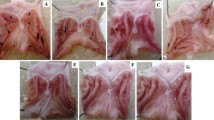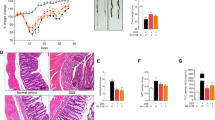Abstract
Indomethacin, the nonselective COX inhibitor, decreased mucosal PGE2 content and caused damage in the intestine within 24 h, accompanied by increase in intestinal motility, bacterial number and MPO, as well as iNOS activity, together with the up-regulation of COX-2 and iNOS mRNA expression. Neither SC-560 nor rofecoxib alone caused intestinal damage, but their combined administration produced lesions. SC-560, but not rofecoxib, caused intestinal hypermotility, bacterial invasion and COX-2 as well as iNOS mRNA expression, yet the iNOS and MPO activity was increased only when rofecoxib was also administered. Although SC-560 inhibited the PG production, the level of PGE2 was recovered, in a rofecoxib-dependent manner. Thus, inhibition of COX-1, despite causing intestinal hypermotility, bacterial invasion and iNOS expression, up-regulates the expression of COX-2, and the the COX-2/PGE2 counteracts deleterious events and maintains the mucosal integrity. This sequence of events explains why intestinal damage occurs when both COX-1 and COX-2 are inhibited.
Similar content being viewed by others
References
Anthony, A., et al. (1993). Early histological features of small intestinal injury induced by in-domethacin, Aliment. Pharmacol. Ther. 7, 29–40.
Anthony, A., et al. (1997). Vascular anatomy defines sites of indomethacin induced jejunal ulceration along the mesenteric margin, Gut 41, 763–770.
Asako, H., et al. (1992). Indomethacin-induced leukocyte adhesion in mesenteric venules; role of lipoxygenase products, Am. J. Physiol. 262, G903–G908.
Bjarnason, I., et al. (1987). Nonsteroidal anti-inflammatory drug-induced intestinal inflammation in humans, Gastroenterology 93, 480–489.
Boughton-Smith, N., et al. (1993). The induction of nitric oxide synthase and intestinal vascular permeability by endotoxin in the rat. Br. J. Pharmacol. 110, 1189–1195.
Brown, J. F., et al. (1992). Differential distribution of nitric oxide synthase between cell fractions isolated from the rat gastric mucosa, Biochem. Biophys. Res. Commun. 184, 680–685.
Chan, C. C., et al. (1995). Pharmacology of a selective cyclooxygenase-2inhibitor L-745,337: a novel non-steroidal anti-inflammatory agent with an ulcerogenic sparing effect in rat and non-human primate stomach, J. Pharmacol. Exp. Ther. 274, 1531–1537.
Fang, W. F., et al. (1997). Indomethacin induced intestinal inflammation, Am. J. Dig. Dis. 22, 749–760.
Feng, L., et al. (1993). Cloning two isoforms of rat cyclooxygenase: Differential regulation of their expression, Arch. Biochem. Biophys. 307, 361–368.
Futaki, N., et al. (1994). NS-398, a new anti-inflammatory agent, selectively inhibits prostaglandin G/ H synthase/ cyclo-oxygenase (COX-2) activity in vitro, Prostaglandins 47, 55–59.
Gretzer, B., et al. (2001). Effects of specific inhibitionof cyclo-oxygenase-1and cyclo-oxygenase-2in the rat stomach with normal mucosa and after acid challenge, Br. J. Pharmacol. 132, 1565–1573.
Ikari, A., et al. (1999). Prostaglandin E2-activated housekeeping Cl_ channels in the basolateral membrane of rat gastric parietal cells, Jpn. J. Physiol. 49, 365–372.
Iso, J.Y., et al. (1995). Isolation and characterization of rat and human glyceraldehyde-3-phosphate dehydrogenase cDNAs: Genomic complexity and molecular evolution of the gene, Nucleic Acids Res. 13, 2485–2502.
Kargman, S., et al. (1993). Characterization of prostaglandin G/ H synthase 1 and 2 in rat, dog, monkey, and human gastrointestinal tracts, Gastroenterology 111, 445–454.
Konaka, A., et al. (1999). Roles of enterobacteria, nitric oxide and neutrophil in pathogenesis of indomethacin-inducedsmall intestinal lesions in rats, Pharmacol. Res. 40, 517–524.
Kunikata, T., et al. (2002a). 16,16-dimethyl prostaglandin E2 inhibits indomethacin-induced small intestinal lesions through EP3 and EP4 receptors, Dig. Dis. Sci. 47, 894–904.
Kunikata, T., et al. (2002b). Protective effect of thiaton, the anti-spasmodic drug, against indomethacin-inducedintestinal ulceration in rats, Jpn. J. Pharmacol. 88, 45–54.
Langenbach, R., et al. (1995). Prostaglandin synthase 1 gene disruption in mice reduces arachidonic acid-induced inflammation and indomethacin-inducedgastric ulceration, Cell 83, 483–492.
O'Neill, G. P. and Ford-Hutchinson, A. W. (1993). Expression of mRNA for cyclooxygenase-1 and cyclooxygenase-2 in human tissues, FEBS Lett. 330, 156–160.
Robert, A. and Asano, T. (1977). Resistance of germ-free rats to indomethacin-induced intestinal inflammation, Prostaglandins 14, 333–341.
Seibert, K., et al. (1994). Pharmacological and biochemical demonstration of the role of cyclo-oxygenase 2 in inflammation and pain, Proc. Natl. Acad. Sci. USA 91, 12013–12017.
Takeuchi, K., et al. (2002). Pathogenic importance of intestinal hypermotility in NSAID-induced small intestinal damage in rats, Digestion 66, 30–41.
Tanaka, A., et al. (2001). Inhibition of both COX-1 and COX-2 is required for development of gastric damage in response to nonsteroidal anti-inflammatory drugs, J. Physiol. (Paris) 95, 21–27.
Tanaka, A., et al. (2002a). Up-regulationof COX-2 by inhibition of COX-1: A key to NSAID-induced intestinal damage, J. Pharmacol. Exp. Ther. 300, 754–761.
Tanaka, A., et al. (2002b). Role of COX-1 and COX-2 inhibition in NSAID-induced intestinal damage in rats: relation to various pathogenic events, J. Pharmacol. Exp. Ther. (in press).
Tanaka, A., et al. (2002c). Mechanism underlying up-regulation of COX-2 in rat small intestine under inhibition of COX-1, Gastroenterology 122, A-230.
Wallace, J. L., et al. (2000). NSAID-induced gastric damage in rats: Requirement for inhibition of both cyclooxygenase 1 and 2, Gastroenterology 119, 706–714.
Weissenborn, U., et al. (1985). Indomethacin-increased gastrointestinal lesions in relation to tissue concentration, food intake and bacterial invasion in the rat, Pharmacology 30, 32–39.
Whittle, B. J. R. (1981). Temporal relationship between cyclooxygenase inhibition, as measured by prostacyclin biosynthesis, and the gastrointestinal damage induced by indomethacin in the rat, Gastroenterology 80, 94–98.
Xie, W. L., et al. (1992). Mitogen-inducible prostaglandin G/ H synthase: A new target for nonsteroidal anti-inflammatory drugs, Drug Dev. Res. 25, 249–265.
Yamada, T., et al. (1993). Mechanisms of acute and chronic intestinal inflammation induced by indomethacin, Inflammation 17, 641–662.
Rights and permissions
About this article
Cite this article
Tanaka, A., Matsumoto, M., Nakagiri, A. et al. NSAID-induced small intestinal damage: role of COX inhibition. Inflammopharmacology 10, 313–325 (2002). https://doi.org/10.1163/156856002321544783
Issue Date:
DOI: https://doi.org/10.1163/156856002321544783




